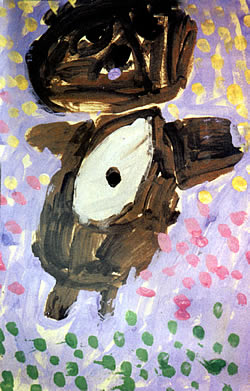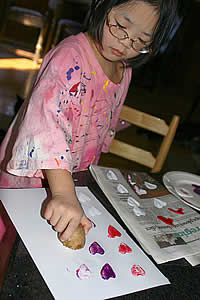Enhancing Literacy Through Process Art
by MaryAnn F. Kohl
Copyright © 2015 Bright Ring Publishing, All rights reserved.
For questions or permissions to reprint, write to us here.
THIS I KNOW:
If you want to hold the attention of a child, read a book out loud to him. If you want to see a child become easily and deeply involved in creativity, give him crayons and paper for free drawing. We know these truths to be self-evident, for we’ve seen and done them so many times we can’t begin to count them!
 Books and art have always been powerful tools for motivating, subduing, intriguing, and delighting children. Indeed, it is proven through research that success in reading is linked to early experiences reading-aloud to children and reading aloud as often as possible. As last month’s article in Collage says, “Reading aloud is more than saying words.” Following up that reading time with related activities such as art increases a child’s love and appreciation of books, and inspires children to return to their favorites with deeper understanding and comprehension.
Books and art have always been powerful tools for motivating, subduing, intriguing, and delighting children. Indeed, it is proven through research that success in reading is linked to early experiences reading-aloud to children and reading aloud as often as possible. As last month’s article in Collage says, “Reading aloud is more than saying words.” Following up that reading time with related activities such as art increases a child’s love and appreciation of books, and inspires children to return to their favorites with deeper understanding and comprehension.
Because picture books are the center of a young child’s step into literacy, following up with easy art ideas that center on the illustrator’s style or technique is a natural progression requiring no great expertise on anyone’s part. Activities use materials found in most classrooms or homes. For example, crayons and blank paper are the perfect combination for a starting point. Try this with a child or small group of children, and judge for yourself: Read-aloud a favorite children’s classic picture book, such as Harold and the Purple Crayon [Crockett Johnson, author and illustrator], as you and your child enjoy the illustrations along with reading the story aloud.
Follow-up the reading time with an incredibly easy and enjoyable art activity: Simply draw on large blank paper with a purple crayon! Draw anything. There is no right or wrong way to explore art. After all, it is the process of exploration and discovering that is most valuable, not the finished product. In other words, enjoy the doing more than the end result. When the purple drawing and coloring and designing and exploring is over, the next time you read Harold and the Purple Crayon to your child, you will notice a remarkable and directly related interest in the illustrations due to this very simple activity. Your child is appreciating art and tying together the enjoyment of reading with the experience of art.
 If the child was particularly enamored with the purple crayon experience, take it a step further on another day: tape purple yarn in rambling and looping designs on a sheet of cardboard or on a tabletop. The yarn will travel great distances with great freedom of creativity. Some children like to color or paint in the spaces in the looping yarn; other are content to loop away the afternoon. When the child hears Harold and the Purple Crayon once again, the appreciation of the illustrations combined with comprehension of the story will be greatly enhanced and ingrained by the hands-on process experience. The child will have a more personal relationship with the book not only hearing it read aloud, but getting to know the book through hands-on process art related to the illustrations.
If the child was particularly enamored with the purple crayon experience, take it a step further on another day: tape purple yarn in rambling and looping designs on a sheet of cardboard or on a tabletop. The yarn will travel great distances with great freedom of creativity. Some children like to color or paint in the spaces in the looping yarn; other are content to loop away the afternoon. When the child hears Harold and the Purple Crayon once again, the appreciation of the illustrations combined with comprehension of the story will be greatly enhanced and ingrained by the hands-on process experience. The child will have a more personal relationship with the book not only hearing it read aloud, but getting to know the book through hands-on process art related to the illustrations.
One of the most loved books and most requested art ideas go hand-in-hand with this follow-up activity, requiring only paper, scissors, crayons, aluminum foil, and glue. Bits of sparkly craft items like sequins or glitter are optional, based on whatever you have on hand. The project honors the process of creativity and does not have a planned outcome. Read aloud Caldecott Award Winner, The Rainbow Fish [Marcus Pfister, author and illustrator]. Enjoy the sparkly illustrations while reading along. Talk about the shiny fish scales and the colors of the Rainbow Fish himself. As a follow-up, place small scraps of aluminum foil, scissors, paper, crayons and glue on the worktable. Invite the child to create a sparkly crayon drawing, incorporating bits of foil glued into the artwork. Though some children will try to create a sparkly rainbow fish, others will most certainly work up abstract colored designs and then snip and tear aluminum foil into bits and shapes to glue into the art. Like snowflakes, rarely are two artworks ever the same if the creative process is honored over the finished product.
Listed below are summaries of quick follow-up art ideas to enhance a child’s love and appreciation of favorite read-aloud picture books:
Corduroy – Don Freeman author/illustrator
– make prints from scraps of corduroy pressed in paint and then on paper
Blueberries for Sal – Robert McCloskey, author/illustrator
– dip a fingertip in blue paint and make finger-dot designs on paper
Elmer – David McKee, author/illustrator
– create patchwork designs, like Elmer’s skin, with collected junk and bright construction paper background
It Looked Like Spilt Milk – Charles Shaw, author/illustrator
– mix ¼ cup white glue with 1 cup frothy shaving cream, and use to fingerpaint white puffy designs on blue or black paper
Ten Black Dots – Donald Crews, author/illustrator
– with any chosen number of black dot stickers, create a design with dots and incorporate the dots in a drawing (4 dots, wheels of a car; 6 dots, apples in a tree; 1 dot; a nose on a puppy; 20 dots, fancy design)
Gilberto and the Wind – Marie Hall Ets, author/illustrator
– draw on green colored paper with pencil and accent parts with white chalk (like the illustrator’s style)
A Tree is Nice – Marc Simont, illustrator; Janice Udry, author
– collect fallen natural materials from trees (leaves, needles, twigs, blossoms), place them under a sheet of paper, and make a crayon rubbing with peeled crayons rubbed over the bumpy design
Alligator Shoes – Arthur Dorros, author/illustrator
– a book about fancy shoes inspires kids to decorate an old pair of sneakers with felt, buttons, rick-rack, and other trims on hand; drawings or tracings of shoes may also be designed and decorated; boots, slippers, flip-flops, and so on.
More Spaghetti I Say – Mort Gerberg, illustrator; Rita Gelman, author
– mix strands of cooked spaghetti and glue in a bowl; stir in glitter or small decorative things if desired; arrange spaghetti strands on aluminum foil dry until hard and shiny. Peel away, and hang by a thread.
Plain paper and crayons will always be the shining star of art follow-up activities for read-aloud book time or any time. Drawing on plain paper with crayon, uninterrupted by an adult, has been proven by research to benefit children in their success in all other subjects.
Art for children doesn’t have to be fancy; it simply must have a moment in time to be offered to a child. Children are capable of looking at illustrations and seeing elements they may wish to explore in their own art. Children are capable of appreciating illustrations for their style, color, and appeal. Children are inspired to love and appreciate books through hands-on companion art experiences.
Give them the gift of opportunity to appreciate their books as they get to know the illustrations first hand and hands-on.
Further Hints and Recommendations
Storybook Art, MaryAnn Kohl and Jean Potter (Bright Ring)
Discovering Great Artists, MaryAnn Kohl and Kim Solga (Bright Ring)
The Psychology of Art: A Psychology Today Book, Rhoda Kellogg (CRM; distributed by Random House)
Analyzing Children’s Art, Rhoda Kellogg (Mayfield Publishing Company)
Creative and Mental Growth (8th Ed), Viktor Lowenfeld (Prentice Hall)
The Best in Children’s Books: The University of Chicago Guide to Children’s Literature
The Hedgie Awards offers a list of the best read-aloud Picture and Chapter books, grouped in categories such as Early Readers and Read-Alones. Visit Kids Art website and find truly creative, inspiring art ideas.
Read Aloud Handbook, Jim Trelease (Penguin USA)
The New York Times Parent’s Guide to the Best Books for Children, Eden Ross Lipson (Random House)
